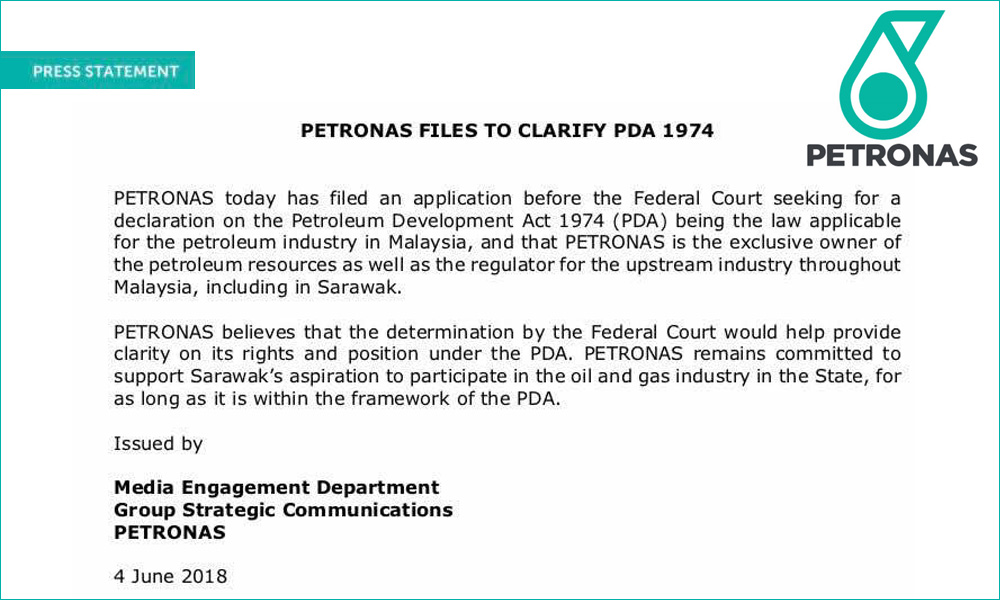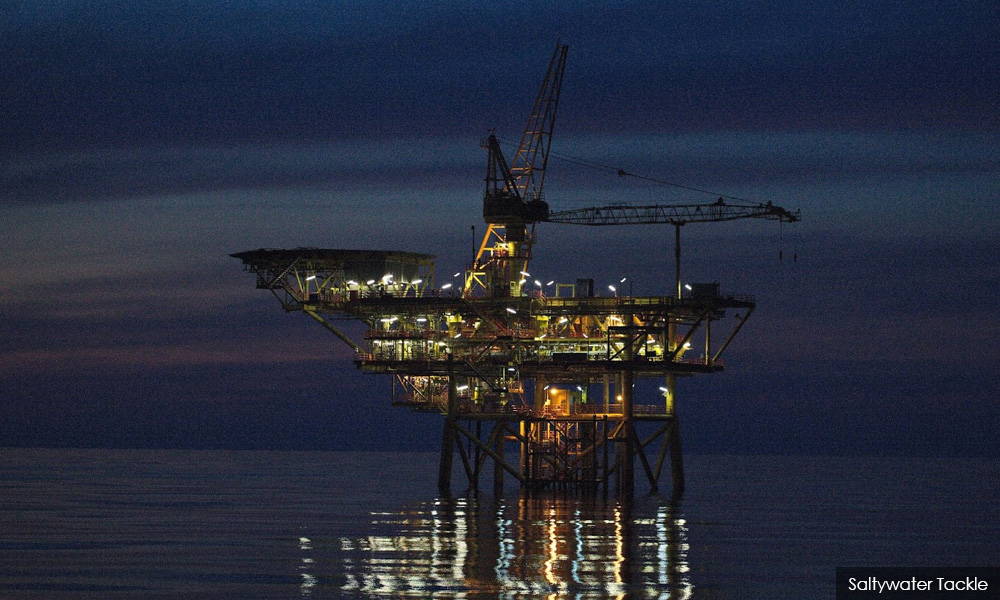COMMENT | Sarawak’s oil and gas (O&G) has been protected by its dominion, namely its legal ownership, sole economic right, and right to issue prospecting licenses, and leases under one or more licences for O&G on its land with proprietary and property rights including its O&G below under the seven protective municipal laws (7 PM laws) of Sarawak before and after Malaysia Day, mainly under its valid and enforceable Sections 3, 4 and 34(1) of the Oil Mining Ordinance 1958 (OMO 1958) and Sarawak Land Code 1958 (SLC 1958) not superseded nor repealed by the Emergency Ordinance (EOs) 1969 nor by the Petroleum Development Act 1974 (PDA 1974) which is a federal legislation under imperium, ultra vires the Federal Constitution (FC), namely under the seven provisions of the FC (7 FCs) void and illegal under the 7 PM laws, therefore invalid and unenforceable against the coastal state of Sarawak.
Consequently, the oil agreement signed between Petronas (purportedly and irrevocably assigned by the federal government) and the Sarawak government and the purported grant of perpetuity of the O&G in Abdul Rahman Ya’akub’s letter signed by him as the chief minister then, to Petronas on the same date on March 27, 1975, suffered the same unconstitutional, void and illegal status as PDA 1974, totally unenforceable against Sarawak and they have also not been approved by the Council Negeri for over 44 years.
As a corollary, under Section 223 of the Companies Act 2016, the CEO and directors cannot dispose of any substantial assets of the company without the approval of its shareholders. The approval of the Council Negeri is imperative. The Seven FCs are Articles 2, 4(1), 80(3), 95(D), 76(4), 162 and items 2(a), (c) and (d) of the State List II Ninth Schedule.
7 PM laws and 7 FCs supercede illegal federal laws and void FCs
The 7 PM laws of Sarawak, particularly before and after Malaysia Day, have been validly passed and enforced by the Sarawak government, namely the 7 FCs after Malaysia Day and the most important Sections 3, 4 and 34(1) of the OMO 1958 now updated more comprehensively under Article 162(2), the Order in Council 1954 (OIC 1954), three years before the Merdeka of Malaya in 1957, sections 32(1)(g), 36(2) and 209(1) on all leases and 112 of the SLC 1958 for registration of all leases to be valid and enforceable, the Supplementary Deed 1956 (SD 1956), Section 3 of the updated Sarawak Interpretation Ordinance 2005 (SIO 2005) of Sarawak reinforcing Article 76 of The United Nations Convention on the Law of the Sea 1982 (UNCLOS 1982), and lastly the Assurances under Article VIII of MA 1963, a multi-lateral treaty and constitutional agreement, for “Assurance, undertaking……in so far as they are not implemented by express provision of the constitution of Malaysia.”
The three specific and fundamental Razak’s binding assurances on 3rd August 1962, pivotal to Sarawak for joining in the formation of Malaysia, were “no domination” of “equal partners” of the Borneo Territories which the federal government would “always consult” them at the state government’s level, with the mandatory approvals of the legislative councils on the amendments of the critical and specific federal legislations and FC under the entrenched provisions of the FC which per se would not be unconstitutional under the 7 FCs and illegal against 7 PM laws of Sarawak, but valid and enforceable under the umbrella of the special safeguards for the Borneo Territories.
On Malaysia Day recently, Prime Minister Dr Mahathir Mohamad promised to implement only the assurance of equal partnership so far. Equal partners refer only to the States of Malaya, Sarawak and North Borneo (Sabah), but not to the individual states of Malaya. Precisely the void and illegal Act 354 of 1976 had tried unsuccessfully to relegate the status of Sarawak and Sabah as equal partners to be the satellite states of Malaysia by amending the original Article 4(2)(b) to Article 1(2) of the FC, similar to the individual states of Malaya. Besides, the Sarawak’s territorial waters were altered without the Council Negeri’s approval under Article 2 of the FC, reflecting, unfortunately, the domination of Kuala Lumpur with no consultation with the state as equal partners. Immigration was specifically entrenched in the Article V of MA 1963, as the strongest and only practical bulwark under the IGC Report 1962, MA 1963 and the FC fought by the Sarawak leaders in from 1962 to 1963.

Article 75 is not overriding
Article 75 of the FC which states that the state law shall be void to the extent inconsistent with the federal law does not apply (i) retrospectively; (ii) under Article 162(2) which expressly states that “nothing in Article 75 shall invalidate the amendments”, for example on the OMO 1958 and SLC 1958 by the Council Negeri; (iii) to the municipal laws, such as OMO 1958, SLC 1958, Order-In Council 1954 (OIC 1954), SD 1956 and (Sarawak) Interpretations Ordinance 1958 (SIO 1958) under Sarawak’s dominion enacted before Malaysia Day; (iv) on those federal legislations, such as the PDA 1974, the Exclusive Economic Zone Act 1984 on O&G under Articles 4 and 5 (EEZ Act 1984) related to O&G and the Territorial Sea Act 2012 (TSA 2012) which are unconstitutional, void, illegal and unenforceable against Sarawak under those entrenched clauses or articles of the FC and unless these Acts have been expressly approved by the Council Negeri under the reinforced rights of the State under Articles 2, 4(1), 73(b), 74(2), 76(3), 80(3) and 162(1) and (2) of the FC, which the Council Negeri has never approved them nor will approve them; (v) when the Federal Acts such as PDA 1974, Articles 4 and 5 of the EEZ Act 1984 and TSA 2012 were promulgated in breach of the entrenched constitutional provisions of Articles 76(4) and 95D of the FC and Items 2(a), (b) and (d) of The State List II, notwithstanding Article 13 of the FC on the purported compulsory acquisition of Sarawak’s O&G with reasonable compensation which is only applicable to the States of Malaya and the Federal Territories without those entrenched constitutional provisions.
Petronas has sued procedurally in the wrong jurisdiction and may restart the case in Sarawak, appeals to the Federal Court or to London with nexus to MA 1963 where it was signed, followed by normal mediations or negotiations and settlements. Yet there is a need for the proposed long-term legal and political win-win solution to be based not fallaciously on the existing federal laws, but on the 7 FCS and 7 PMS laws of Sarawak and international laws and MA1963 as a multilateral treaty and constitutional agreement to resolve this matter before the O&G run dry earlier than expected and before prime minister Dr Mahathir Mohamad leaves office.

The best shallow fields with low costs of production have been substantially creamed off and issued for the last four decades with increased speed recently in the Baram offshore area, Luconia, Central Luconia with carbonated reefs with shale seals, Balingian out of the eight geological formations, leaving behind the deep waters near East Natuna with treatable 20 percent CO2, with more gas than oil, unlike Natuna Indonesia with polluting 70 percent CO2, too much to bottle Coca-Cola. Now, deep waters would have less risk with the revised R/C Index and Capital Allowances with the Threshold Volume (THV) of the fourth generation of PSCs (product sharing contracts) with 3D seismics looking for more “kitchens” with treatable CO2, similar to Kawasari with six to seven trillion cubic feet (TCF) of gas.
At US$40 per barrel, after paying the very affordable 20 percent royalty, the share of profit of oil is still over 35 percent pure revenue for the federal government; and at US$6/mcf for gas (barrel of oil equivalent, boe), after minus the very affordable 20 percent royalty, the federal government share of profit is around 30 percent (boe) in addition to the four taxes/impositions and equity cash flows of about two to three percent as explained later and the profit of Petronas with some carried interests. Unfortunately, oil recovery is only 29 percent with small EOR (Enhancement of oil recovery), if feasible and for gas, 40 percent. About 75 to 80 percent of the present proven oil reserves have been extracted already. The estimated 100 million bbl oil around Canada Hill, Miri, sealed off before the Japanese landed, were sterilised by environmental problems.
There are several recent discoveries in Baram Delta oil fields and nearby areas with more discoveries in Nuang, Seraling, Bakong, Boker SK 318, SK 320, SK 2B, SK 408, SK 314A and others. PTTEP has farmed in 42.5 percent interest in SK 410B. Pertamina has bought 30 percent interest of the Murphy oil asset of half-a-billion bbl/oil/boe for US$2 billion, based on public information and from the foreign and local O&G companies and contractors including the sums and parts, Ebita and IRR (internal rate of return). Petros should team up with Petronas and others on a win-win joint venture format with the right of pre-emption to all the PSCs of the present and future under all the new restructured PSCs by Petros.
We hope the sagacious Mahathir will right all the omissions and wrongs done to the Borneo Territories soonest while carrying out his national rescue packages of our blood-stream and accept Sarawak’s plea:
MA 1963’s restoration embodies review, revision and reformation
Of rights safeguards and breaches of law Assurances and Constitution
Borneo States’ offshore oil and all assets under the Dominion concept
Of 350 nautical miles outside Imperium, Federal urged to accept
Our constitution, municipal laws, treaty we ply
Restoration, empowerment, and equity our case will lie.
ALEX LING holds a postgraduate law degree from Cambridge University, and specialises in constitutional, public and private international law. His father, former Sarawak Chinese Association president Ling Beng Siew played a pivotal role in Sarawak joining in the formation of Malaysia in Rumah Malaysia, Sibu.
The views expressed here are those of the author/contributor and do not necessarily represent the views of Malaysiakini.

